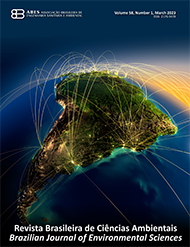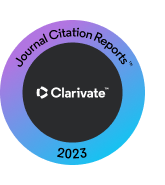Synergistic nutrient removal by native microalgae-bacteria consortium: key parameter evaluation
DOI:
https://doi.org/10.5327/Z2176-94781962Keywords:
nutrient bioremediation; domestic wastewater treatment, nitrogen and phosphorus removal, regression analysis.Abstract
Nutrient bioremediation processes in wastewater are becoming a prevalent focus of research, with microalgae emerging as prominent players. Such microorganisms provide a compelling alternative to traditional sanitation approaches. In light of this emerging interest, the main objective of this study was to explore diverse growth conditions of a native microalgae-bacteria consortium in domestic wastewater, aiming at nutrient bioremediation and biomass production. The investigation was performed on a laboratory scale through Schott® 2.0 L glass bottle photobioreactors, utilizing anaerobically digested wastewater to mitigate its polluting potential effectively. At first, the impact of increasing inflow of CO2 was evaluated. It was found that the addition of 5% CO2 yielded the most favorable outcomes, with the remarkable 96.5% of total phosphorus removal within four days alongside a biomass production rate of 0.04 g.L-1.d-1. In later steps, variations in light intensity were analyzed, and with 304±3 μmol.m-2.s-1, yielded the most promising results, with total phosphorus removal of 97.1% within two days and biomass production rate of 0.31 g.L-1.d-1. Finally, the influence of temperature was assessed, uncovering 97.2% total phosphorus removal within two days, complemented by a biomass production rate of 0.29 g.L-1.d-1. These results facilitated the development of a surface model illustrating the intricate relationship between light and temperature for this consortium. Furthermore, the consortium exhibited remarkable proficiency in nutrient removal from anaerobically digested wastewater, showcasing noteworthy resilience to temperature and light intensity fluctuations.
Downloads
References
Aditya, L.; Mahlia, T.M.I.; Nguyen, D.D.; Nguyen, L.N.; Vu, H.P.; Nghiem, L.D., 2022. Microalgae-bacteria consortium for wastewater treatment and biomass production. Science of The Total Environment, v. 838 Part 1, 155871-155871. https://doi.org/10.1016/j.scitotenv.2022.155871.
Alcántara, C.; De Godos, I.; Muñoz, R., 2020. Wastewater treatment and biomass generation with algae. In: Olivares, J.A.; Puyol, D.; Melero, J.A.; Dufour, J. Wastewater treatment residues as resources for biorefinery products and biofuels. Elsevier, pp. 229-254. https://doi.org/10.1016/B978-0-12-816204-0.00011-4.
American Public Health Association (APHA), 2012. Standard methods for the examination of water and wastewater. 22. ed. American Public Health Association, Washington, DC, 2012.
Barboza-Rodríguez, R.; Rodríguez-Jasso, R.M.; Rosero-Chasoy, G.; Rosales-Aguado, M.L.; Ruiz, H.A., 2024. Photobioreactor configurations in cultivating microalgae biomass for biorefinery. Bioresource Technology, v. 394, 130208. https://doi.org/10.1016/j.biortech.2023.130208.
Beltrán-Rocha, J.C.; Barceló-Quintal, I.D.; García-Martínez, M.; Osornio-Berthet, L.; Saavedra-Villarreal, N.; Villarreal-Chiu, J.; López-Chuken, U.J., 2017. Polishing of municipal secondary effluent using native microalgae consortia. Water Science and Technology, v. 75 (7), 1693-1701. https://doi.org/10.2166/wst.2017.046.
Bernard, O.; Rémond, B., 2012. Validation of a simple model accounting for light and temperature effect on microalgal growth. Bioresource Technology, v. 123, 520-527. https://doi.org/10.1016/j.biortech.2012.07.022.
Chia, S.R.; Chew, K.W.; Leong, H.Y.; Ho, S.H.; Munawaroh, H.S.H.; Show, P.L., 2021. CO2 mitigation and phycoremediation of industrial flue gas and wastewater via microalgae-bacteria consortium: possibilities and challenges. Chemical Engineering Journal, v. 425, 131436. https://doi.org/10.1016/j.cej.2021.131436.
Delgadillo-Mirquez, L.; Lopes, F.; Taidi, B.; Pareau, D., 2016. Nitrogen and phosphate removal from wastewater with a mixed microalgae and bacteria culture. Biotechnology Reports, v. 11, 18-26. https://doi.org/10.1016/j.btre.2016.04.003.
Gonçalves, A.L.; Pires, J.C.M.; Simões, M., 2017. A review on the use of microalgal consortia for wastewater treatment. Algal Research-Biomass Biofuels and Bioproducts, v. 24, 403-415. https://doi.org/10.1016/j.algal.2016.11.008.
Kaya, V.M.; Goulet, J.; de la Noüe, J.; Picard, G., 1996. Effect of intermittent CO2 enrichment during nutrient starvation on tertiary treatment of wastewater by alginate-immobilized Scenedesmus bicellularis. Enzyme and Microbial Technology, v. 18 (8), 550-554. https://doi.org/10.1016/0141-0229(95)00167-0.
Kube, M.; Jefferson, B.; Fan, L.; Roddick, F.A., 2018. The impact of wastewater characteristics, algal species selection and immobilisation on simultaneous nitrogen and phosphorus removal. Algal Research-Biomass Biofuels and Bioproducts, v. 31, 478-488. https://doi.org/10.1016/j.algal.2018.01.009.
Lee, Y.-J.; Lei, Z., 2019. Microalgal-bacterial aggregates for wastewater treatment: a mini-review. Bioresource Technology Reports, v. 8, 100199. https://doi.org/10.1016/j.biteb.2019.100199.
Li, Y.; Zhou, W.; Hu, B.; Min, M.; Chen, P.; Ruan, R., 2012. Effect of light intensity on algal biomass accumulation and biodiesel production for mixotrophic strains Chlorella kessleri and Chlorella protothecoide cultivated in highly concentrated municipal wastewater. Biotechnology and Bioengineering, v. 109 (9), 2222-2229. https://doi.org/10.1002/bit.24491.
Liu, X.; Ying, K.; Chen, G.; Zhou, C.; Zhang, W.; Zhang, X.; Cai, Z.; Holmes, T.; Tao, Y., 2017. ‘Growth of Chlorella Vulgaris and Nutrient Removal in the Wastewater in Response to Intermittent Carbon Dioxide.’ Chemosphere, v. 186, 977-985. https://doi.org/10.1016/j.chemosphere.2017.07.160.
Mayhead, E.; Silkina, A.; Llewellyn, C.A.; Fuentes-Grünewald, C.2018. Comparing nutrient removal from membrane filtered and unfiltered domestic wastewater using Chlorella vulgaris. Biology, v. 7 (1), 12. https://doi.org/10.3390/biology7010012.
Mohsenpour, S.F.; Hennige, S.; Willoughby, N.; Adeloye, A.; Gutierrez, T., 2021. Integrating micro-algae into wastewater treatment: a review. Science of The Total Environment, v. 752, 142168. https://doi.org/10.1016/j.scitotenv.2020.142168.
Mustafa, S.; Bhatti, H.N.; Maqbool, M.; Iqbal, M., 2021. Microalgae biosorption, bioaccumulation and biodegradation efficiency for the remediation of wastewater and carbon dioxide mitigation: prospects, challenges and opportunities. Journal of Water Process Engineering, v. 41, 102009. https://doi.org/10.1016/j.jwpe.2021.102009.
Yu, Q.; Pei, X.; Wei, Y.; Naveed, S.; Wang, S.; Chang, M.; Zhang, C.; Ge, Y., 2023. The roles of bacteria in resource recovery, wastewater treatment and carbon fixation by microalgae-bacteria consortia: a critical review. Algal Research, v. 69, 102938-102938. https://doi.org/10.1016/j.algal.2022.102938.
Pompei, C.M.E.; Bolzani, H.R.; da Silva, G.H.R., 2023. Use of native microalgae in anaerobic sewage treatment: lab and pilot-scale approaches. Journal of Applied Phycology, v. 35, 2865-2879. https://doi.org/10.1007/s10811-023-03081-1.
Ruas, G.; Serejo, M.L.; Paulo, P.L.; Boncz, M.Á., 2018. evaluation of domestic wastewater treatment using microalgal-bacterial processes: effect of CO2 addition on pathogen removal. Journal of Applied Psychology, v. 30 (2), 921-929. https://doi.org/10.1007/s10811-017-1280-6.
Silva, D.F.S.; Speranza, L.G.; Quartaroli, L.; Moruzzi, R.B.; Silva, G.H.R. da, 2020. Separation of microalgae cultivated in anaerobically digested black water using moringa oleifera lam seeds as coagulant. Journal of Water Process Engineering, v. 39, 101738. https://doi.org/10.1016/j.jwpe.2020.101738.
Silva, G.H.R. da; Sueitt, A.P.E.; Haimes, S.; Tripidaki, A.; van Zwieten, R.; Fernandes, T.V., 2019. Feasibility of closing nutrient cycles from black water by microalgae-based technology. Algal Research-Biomass Biofuels and Bioproducts, v. 44, 101715. https://doi.org/10.1016/j.algal.2019.101715.
Sirohi, R.; Pandey, A.K.; Ranganathan, P.; Singh, S.; Udayan, A.; Awasthi, M.A.; Hoang, A.T.; Chilakamarry, C.R.; Kim, S.H.; Sim, S.J., 2022. Design and applications of photobioreactors- a review. Bioresource Technology, v. 349, 126858. https://doi.org/10.1016/j.biortech.2022.126858.
Sutherland, D.L.; Ralph, P.J., 2019. Microalgal bioremediation of emerging contaminants - opportunities and challenges. Water Research, v. 164, 114921-114921. https://doi.org/10.1016/j.watres.2019.114921.
Torres-Franco, A.; Passos, F.; Figueredo, C., Mota, C.; Muñoz, R., 2021. Current advances in microalgae-based treatment of high-strength wastewaters: challenges and opportunities to enhance wastewater treatment performance. Reviews in Environmental Science and Bio/Technology, v. 20, 209-235. https://doi.org/10.1007/s11157-020-09556-8.
Wali, M.E.; Rahimpour Golroudbary, S.; Kraslawski, A., 2021. Circular economy for phosphorus supply chain and its impact on social sustainable development goals. Science of The Total Environment, v. 777, 146060-146060. https://doi.org/10.1016/j.scitotenv.2021.146060.
Zhang, B.; Li, W.; Guo, Y.; Zhang, Z.; Shi, W.; Cui, F.; Lens, P.N.L.; Tay, J.H., 2020. Microalgal-bacterial consortia: from interspecies interactions to biotechnological applications. Renewable & Sustainable Energy Reviews, v. 118, 109563. https://doi.org/10.1016/j.rser.2019.109563.
Published
How to Cite
Issue
Section
License
Copyright (c) 2024 Revista Brasileira de Ciências Ambientais

This work is licensed under a Creative Commons Attribution 4.0 International License.


























